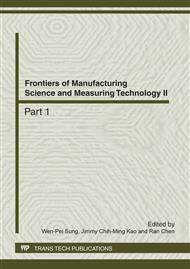p.103
p.107
p.111
p.115
p.119
p.123
p.127
p.132
p.136
Investigation into Normal Pressure during Electrorheological Fluid-Assisted Polishing
Abstract:
The normal pressure in polishing area is investigated in electrorheological (ER) fluid-assisted polishing process. Under the influence of the non-uniform electric field, the dielectric particles in the ER polishing fluid are polarized to form the rigid core attached to the tool electrode due to the ER effect. In this work, the rigid core generated by the gathered mass of ER polishing fluid on the tip of tool electrode with the applied electric field is analyzed. The material is removed by abrasive particles under the effect of normal pressure and velocity. Based on the theory of hydrodynamic lubrication, a mathematical model taking into account the normal pressure is derived. Further experiments about the normal pressure experiments changing with the applied voltage, spindle rotational speed and working gap are conducted and the experimental results are compared with the theoretical results, which confirm the validity of the presented model
Info:
Periodical:
Pages:
119-122
Citation:
Online since:
April 2012
Authors:
Keywords:
Price:
Сopyright:
© 2012 Trans Tech Publications Ltd. All Rights Reserved
Share:
Citation:


